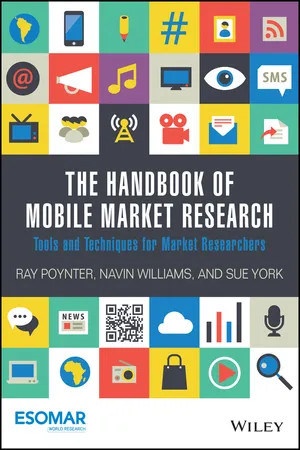
The Handbook of Mobile Market Research
Tools and Techniques for Market Researchers
- English
- ePUB (mobile friendly)
- Available on iOS & Android
The Handbook of Mobile Market Research
Tools and Techniques for Market Researchers
About This Book
The premier guide to mobile market research
The Handbook of Mobile Market Research is the first guide to focus exclusively on the use of mobile technology in market research. From a global perspective, more people own mobile phones than landlines or computers, and most people have their mobile phones with them at all times—along with their tablets, smartwatches, media players, and navigation devices. The continuous surge of mobile innovation provides unprecedented access to real-time consumer behaviour. Mobile market research allows users to reach more people, engage more people, and collect more valuable data as respondents are free to engage at their own pace, on their own time.
Industry forerunners Ray Poynter, Navin Williams, and Sue York employ decades of study to examine the present and future state of mobile market research, as well as the advantages and disadvantages of various approaches. This book contains clear, comprehensive knowledge for those who implement, utilise, and study the field. Readers will learn:
- The characteristics, scope, and importance of mobile market research
- Purposes and effects of principal tools like brand tracking, ad testing, customer satisfaction research, and research technology
- How mobile devices are used for qualitative and quantitative research by way of online focus groups, online discussions, mobile diaries, mobile ethnographies, and mobile surveys
- Aspects and implications of mobile computer interviews, mobile phone interviews, mixed-mode research, international mobile research, and research using passive data, panels, lists, and communities
- The significance of the mobile ecosystem, market research ethics, and research on research
Designed to be accessible and helpful for beginners and advanced users alike, The Handbook of Mobile Market Research is an extensive guide to one of the most promising, dynamic methods of data collection.
Frequently asked questions
PART I
Mobile Market Research
- Overview of Mobile Market Research
- Mobile Research in Action
- The Technology of Mobile Market Research
1
Overview of Mobile Market Research
INTRODUCTION
WHAT DOES MOBILE MARKET RESEARCH MEAN?
- Quantitative research where the participants complete surveys on their mobile device.
- Mixed-mode quantitative studies, where some participants complete surveys via a PC while others use a mobile device.
- Quantitative research where participants allow applications on their mobile device to gather information about them or their environment, referred to as passive data collection.
- Qualitative research, where the mobile device either facilitates communication (e.g. taking part in an online focus group from a tablet), or facilitates data collection (e.g. collecting photos and recordings), or a combination of the two.
- Research communities where the mobile device is a key method of communication or participation.
- Face-to-face research where the interviewers are using mobile devices to collect data, sometimes referred to as mCAPI (CAPI utilizing a mobile device).
STANDARDIZED SOLUTIONS FOR MOBILE MARKET RESEARCH
WHY THE INTEREST IN MOBILE?
- The growing ubiquity of mobile devices.
- People having their phones with them all the time, facilitating ‘in the moment’ research.
- Growth in more powerful mobile devices, especially smartphones and tablets.
- Passive data collection, recording information about participants without their having to actively enter information.
1. THE UBIQUITY OF MOBILE PHONES
- 6.8 billion mobile phones estimated to be in use, compared with the global population of about 7.2 billion.
- By the end of 2012, over 50% of the world's population were living in areas with at least 3G coverage.
- By the end of 2013 there were almost 2 billion mobile broadband subscriptions – with Ericsson forecasting that by the end of 2018 this figure would be 6.5 billion.
2. ‘IN THE MOMENT’
3. PUTTING THE ‘SMART’ IN MOBILE MARKET RESEARCH
4. PASSIVE DATA COLLECTION
Table of contents
- Cover
- Epigraph
- Title Page
- Copyright
- Dedication
- Foreword
- Introduction
- Part I: Mobile Market Research
- Part II: Qualitative and Quantitative Research
- Part III: The Methods and Applications of Mobile Market Research
- Part IV: Researching the Mobile Ecosystem, Ethics, and the Future
- Glossary
- References
- About the Authors
- A Note of Thanks
- Index
- End User License Agreement